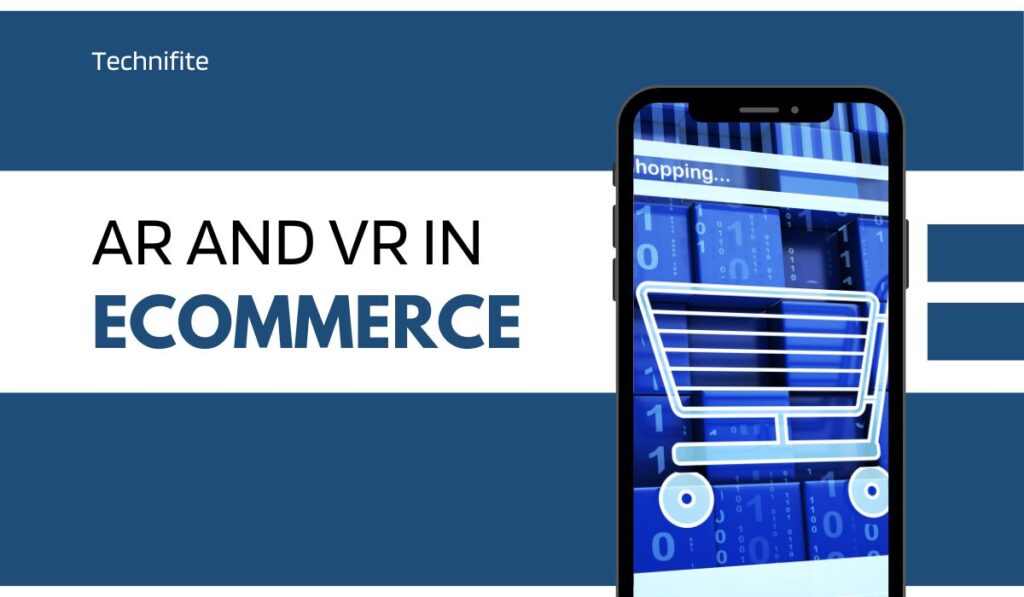AR and VR in eCommerce: In the ever-evolving landscape of eCommerce, businesses are constantly exploring innovative ways to engage customers and enhance their shopping experience. One of the most transformative technologies in recent years has been Augmented Reality (AR) and Virtual Reality (VR). These technologies have not only blurred the lines between the physical and digital worlds but have also revolutionized how consumers perceive and interact with products. In this blog post, we will delve into the exciting realm of AR and VR in eCommerce, exploring how they are reshaping the industry and creating immersive shopping experiences like never before.
The Rise of AR and VR in eCommerce
Integrating AR and VR technologies in eCommerce has opened up new avenues for businesses to showcase their products and services. Augmented Reality overlays digital information onto the real world, allowing users to interact with virtual objects in their physical environment. On the other hand, Virtual Reality creates a completely immersive digital environment, transporting users to a different world altogether. Both these technologies have found profound applications in the retail sector, transforming how consumers shop online.
AR in eCommerce: Bridging the Gap Between Online and Offline Shopping
Virtual Try-Ons and Product Visualization
One of the significant advantages of AR in eCommerce is its ability to enable virtual try-ons. Customers can now visualize how products like clothing, accessories, or even furniture would look on them or in their homes before purchasing. This feature not only enhances the shopping experience but also reduces the rate of product returns, as customers have a clearer understanding of what they are buying.
Interactive Product Demos
AR-powered interactive product demonstrations have become a game-changer for eCommerce businesses. Customers can engage with products in real time, exploring their features and functionalities before buying. For instance, a customer interested in a camera can now experience its various settings and capture quality through an AR simulation, providing a comprehensive understanding of the product’s capabilities.
AR-Based Navigation and In-Store Experience
In online retail, AR navigation tools have emerged, allowing customers to navigate through stores virtually. These applications simulate the in-store experience, enabling users to explore different sections, view product details, and even receive personalized recommendations. This feature not only enhances customer engagement but also replicates the convenience of physical shopping from the comfort of one’s home.
VR in eCommerce: Creating Immersive Shopping Environments
Virtual Storefronts
VR technology has paved the way for virtual storefronts, where customers can browse products in a 3D environment. These virtual stores mimic real-world retail spaces, complete with shelves, displays, and even interactive elements. Customers can move around, pick up items, and inspect them closely, providing a highly immersive shopping experience.
Virtual Shopping Assistants
VR-powered virtual shopping assistants are revolutionizing customer service in eCommerce. These virtual assistants, powered by artificial intelligence, guide customers through the shopping process, answer queries, and provide product recommendations. The interactive nature of VR enhances the effectiveness of these assistants, making the shopping experience not just transactional but also informative and engaging.
Virtual Events and Experiential Marketing
In the age of social distancing, VR technology has enabled eCommerce businesses to host virtual events and experiential marketing campaigns. From product launches to fashion shows, businesses can create immersive virtual experiences that allow customers to participate, interact, and even make purchases, all within the virtual environment. This innovative approach not only generates buzz but also fosters a sense of community among customers.
Challenges and Future Trends
While AR and VR in eCommerce have unlocked incredible possibilities, there are challenges that businesses need to address, such as the cost of implementing these technologies, ensuring seamless user experiences, and widespread adoption among consumers. However, as technology advances, these challenges are gradually being mitigated.
Looking ahead, the future of AR and VR in eCommerce seems promising. As these technologies become more accessible and affordable, we expect to see a surge in their integration across various industries. Additionally, advancements in artificial intelligence, haptic feedback, and 5G connectivity will further enhance the immersive capabilities of AR and VR, providing consumers with unparalleled shopping experiences.
Conclusion
In the fast-paced world of eCommerce, staying ahead of the curve is essential for businesses looking to capture the attention of tech-savvy consumers. Augmented and Virtual Reality have emerged as powerful tools, enabling businesses to create immersive, interactive, personalized shopping experiences. As these technologies evolve, the line between the physical and digital shopping realms will blur even further, ushering in a new era of eCommerce where imagination knows no bounds. Embracing AR and VR is not just an option; it’s necessary for businesses aspiring to redefine the future of online retail. As we move forward, the fusion of technology and commerce will continue to shape how we shop, revolutionizing the eCommerce landscape and transforming the essence of retail therapy.
Frequently Asked Questions (FAQs)
What is the difference between Augmented Reality (AR) and Virtual Reality (VR)?
Augmented Reality (AR) overlays digital content onto the real world, enhancing the user’s perception of their surroundings by adding computer-generated elements. Virtual Reality (VR), on the other hand, creates a completely immersive digital environment, isolating users from the real world and immersing them entirely in a computer-generated experience.
How are AR and VR enhancing the eCommerce shopping experience?
AR and VR enhance the eCommerce shopping experience by enabling virtual try-ons, interactive product demos, and immersive virtual storefronts. AR allows customers to visualize products in their real environment. At the same time, VR creates immersive environments for browsing products, trying them on virtually, and even interacting with virtual shopping assistants, making online shopping more engaging and informative.
Are AR and VR technologies accessible to small eCommerce businesses?
Yes, AR and VR technologies are becoming increasingly accessible to small eCommerce businesses. Some cost-effective solutions and platforms offer AR and VR development tools, allowing businesses of various sizes to implement these technologies. Additionally, as the technology advances, the costs associated with AR and VR are expected to decrease, making them even more accessible to smaller businesses.
Can AR and VR reduce product returns in eCommerce?
Yes, AR and VR can significantly reduce product returns in eCommerce. Virtual try-ons and interactive product demos give customers a more realistic understanding of the products they are interested in. By experiencing products virtually before purchasing, customers are less likely to be dissatisfied with their purchases, leading to a decrease in return rates.
What is the future of AR and VR in eCommerce?
The future of AR and VR in eCommerce is incredibly promising. As technology advances, we can expect more seamless and immersive experiences. Advancements in artificial intelligence, haptic feedback, and 5G connectivity will further enhance the capabilities of AR and VR, leading to more widespread adoption. These technologies will continue to shape the future of online retail, offering customers unparalleled shopping experiences and transforming how businesses interact with their audience.


